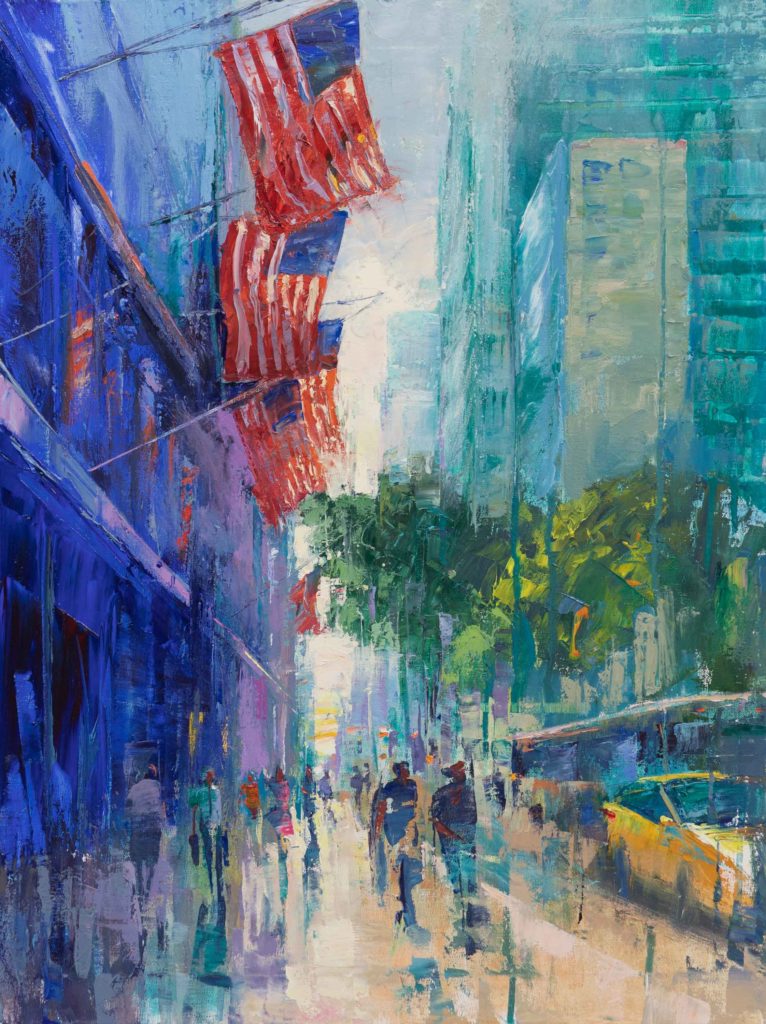Discovering All Concerning Oil Paints: An Overview to Understanding Their Appeal and Worth
Oil paintings have actually captivated audiences for centuries, providing a glimpse right into the creative mastery of different eras. Their rich background is linked with ingenious techniques and extensive psychological expression. Recognizing the materials and methods behind these art work can improve recognition. Furthermore, the market for oil paints provides possibilities for collectors and capitalists alike. As one explores this interesting world, the concern arises: what makes an oil painting truly important?
The History of Oil Paint: A Trip Via Time
Although oil paint has origins that date back to old times, it genuinely thrived throughout the Renaissance, when artists uncovered its convenience and abundant color capacity. Early examples can be mapped to the 7th century, with methods progressing especially throughout societies. The medium came to be noticeable in Northern Europe in the 15th century, particularly through the jobs of musicians like Jan van Eyck, who originated its use for in-depth realism and vivid tones. This period marked a departure from tempera paints, enabling better deepness and texture. As oil painting spread, it influenced many musicians, bring about masterpieces by renowned figures such as Leonardo da Vinci and Rembrandt. The medium's heritage proceeds, forming the art world well right into modern-day times.
Recognizing Oil Paints: Products and Techniques
As musicians discover the world of oil paints, they encounter a varied array of products and techniques that define this tool. The main elements of oil paint include pigments, which supply shade, and drying oils, such as linseed, that bind the pigments and help with application. Numerous ingredients can customize the paint's structure and drying time, improving versatility. Methods like glazing, where transparent layers are developed, and impasto, which includes using thick paint, enable various aesthetic effects. Additionally, the use of brushes, scheme blades, and even fingers can produce special structures and coatings. Understanding these products and methods allows musicians to fully reveal their creative thinking and achieve the wanted influence in their artwork.
The Duty of Shade in Oil Paints
Color plays a critical duty in oil paints, affecting both aesthetic charm and emotional resonance. Comprehending color theory basics, including the connections between colors, can enhance an artist's capacity to share state of mind and ambience. In addition, understanding color blending techniques enables for higher deepness and splendor in a paint's palette.

Color Theory Fundamentals
Comprehending shade theory is important for artists working with oil paints, as it forms the foundation for creating harmonious and visually engaging compositions. Shade concept includes the research study of just how shades interact, the color wheel, and the partnerships between key, additional, and tertiary shades. Musicians use complementary shades to boost contrasts and create prime focus, while comparable shades advertise unity and cohesiveness within a piece. In addition, the principles of great and cozy shades influence the assumption of depth and room in a paint. Grasping these concepts permits musicians to manipulate shade efficiently, directing the audience's eye and interacting their designated message. Proficiency of color concept inevitably enriches a musician's capacity to share emotions and concepts via their work.
Emotional Impact of Color
The psychological impact of shade in oil paints plays a critical function in how viewers link and perceive with artwork. Shades stimulate certain feelings and state of minds, influencing the customer's emotional state. Cozy shades like reds and oranges can create a sense of heat and power, while cool tones such as blues and environment-friendlies commonly evoke calmness or self-contemplation. Artists purposefully select color combinations to enhance narrative aspects, leading the target market's emotional journey. The saturation and contrast of colors additionally magnify these results, drawing attention and creating emphasis. Inevitably, the interplay of shades in oil paintings not just boosts their aesthetic charm but additionally serves as an effective tool for emotional expression, enhancing the customer's experience and interpretation.
Shade Combining Techniques
While many facets of oil painting add to the overall composition, grasping shade mixing strategies is essential for accomplishing desired results and deepness. Color mixing can be approached with numerous techniques, consisting of the subtractive and additive processes. Additive mixing includes integrating shades of light, while subtractive blending relies upon pigments, where shades blend to develop new shades. Artists usually use a minimal combination to develop unified jobs, comprehending the connections between main, second, and tertiary colors. Methods such as glazing and scumbling additionally boost depth and brightness. By skillfully blending shades, an artist can evoke emotions, create prime focus, and achieve a feeling of realistic look, eventually raising the paint's visual and emotional impact.
Famous Oil Painters and Their Iconic Works

Famed for their mastery of shade and method, oil painters have created some of the most renowned artworks in background. Prominent artists like Vincent van Gogh captivated target markets with his stirring brushwork in "Starry Evening," while Claude Monet's "Impression, Daybreak" laid the groundwork for Impressionism. Leonardo da Vinci's "Mona Lisa" stays an enduring sign of artistic genius, showcasing his skill in capturing human expression. Rembrandt's "The Night Watch" illustrates his cutting-edge usage of light and darkness. Various other remarkable numbers include Pablo Picasso, that changed modern-day art with his bold experimentation in jobs like "Les Demoiselles d'Avignon," and Georgia O'Keeffe, whose vivid representations of landscapes and flowers helped define American modernism. Each artist's unique design added substantially to the oil painting landscape.
Exactly how to Assess the High Quality of an Oil Painting
Examining the top quality of an oil paint involves a cautious evaluation of craftsmanship techniques, as well as an analysis of color and make-up. Observing brushwork, layering, and the application of paint can disclose the musician's ability level. Additionally, the interaction of shades and the overall setup of components add significantly to the painting's aesthetic worth.
Analyzing Workmanship Strategies
A thorough assessment of craftsmanship strategies is vital for establishing the high quality of an oil painting. Critics should first analyze the application of paint; thick, distinctive brushstrokes may recommend an experienced hand, while overly consistent applications might indicate a lack of deepness. oil paintings for sale. The layering technique is also essential; the existence of glazes and differed thickness can boost brightness and complexity. In addition, the high quality of the products utilized, such as the canvas and pigments, plays a significant duty in longevity and general aesthetic. Focus to detail in components like edges and changes between shades reflects the musician's dedication to their craft. Eventually, these techniques contribute to the paint's psychological influence and market value, functioning as signs of the musician's skill and intent
Examining Shade and Composition
While examining the top quality of an oil painting, one should concentrate on the interaction of shade and make-up, as these aspects are basic to the art work's overall impact. Color choices can evoke feelings and develop mood; therefore, the musician's palette need to be analyzed for harmony and comparison. A healthy make-up routes the viewer's eye and creates a sense of unity. Artists often utilize methods like the policy of thirds or leading lines to boost aesthetic rate of interest. Furthermore, the usage of light and darkness can add depth, enhancing the three-dimensionality click here of the paint. Inevitably, an effective oil paint weds color and structure, engaging the audience and inviting a deeper appreciation of the artist's vision and strategy.
Taking care of and Preserving Oil Paintings
Proper care and preservation of oil paintings is necessary for maintaining their integrity and long life. To secure these artworks, it is important to display them far from straight sunlight, which can create fading and staining. Preserving a steady environment with regulated temperature and moisture additional aids in avoiding damages. Cleansing must be done carefully making use of a soft, completely dry cloth, staying clear of any type of harsh chemicals that can damage the paint or varnish. Regular evaluations for indications of degeneration, such as flaking or breaking, are advisable. When storing or transporting oil paintings, correct cushioning and framing are necessary to stay clear of physical injury. Eventually, attentive care adds to the visual charm and value of oil paints in time.
The Marketplace for Oil Paintings: Gathering and Spending
Understanding the marketplace dynamics for oil paintings is essential for enthusiasts and investors alike. The value of these art work is affected by different aspects, including the musician's credibility, historic importance, and existing patterns. Collectors frequently seek items that resonate directly while taking into consideration potential recognition in value. Galleries and auctions work as key locations for acquiring and selling, with costs changing based upon need and rarity. Buying oil paintings needs research into the market, along with an understanding of authenticity and provenance. Additionally, emerging artists may provide chances for considerable returns, while established names can command high prices. Overall, a critical approach to collecting can yield both aesthetic satisfaction and monetary rewards.

Often Asked Inquiries
What Are the Environmental Impacts of Oil Paint Materials?
The environmental effects of oil paint products consist of the launch of unpredictable natural substances (VOCs), hazardous waste generation, and resource extraction for pigments. These aspects add to air pollution and eco-friendly degradation, elevating concerns among environmentally mindful artists and consumers.
Exactly How Do Different Canvases Impact Oil Painting Results?
Different canvases affect oil paint results substantially. Absorbency, surface area, and appearance quality can modify paint application, drying out times, and shade vibrancy. Musicians commonly select particular canvases to achieve desired effects and boost their creative expression.
Can Oil Paintings Be Brought Back if Damaged?
If damaged, Oil paintings can indeed be recovered. Specialist conservators use different techniques to repair splits, tidy surface areas, and address discoloration, guaranteeing that the artwork keeps its original elegance and worth for future generations.
What Are the Signs of an Initial Oil Paint?
The signs of an initial oil painting include noticeable brush strokes, texture variants, and an uneven canvas weave (oil paintings for sale). In addition, credibility may be validated through provenance, trademarks, and the visibility of a varnish layer unique to oil tools
Just How Has Innovation Influenced Modern Oil Paint Techniques?
Innovation has considerably influenced modern oil painting techniques by presenting electronic devices for planning, enhanced materials for appearance and long life, and on-line systems for sharing and marketing art, consequently broadening artists' creative opportunities and target market reach. Oil painting has origins that date back to old times, it really thrived during the Renaissance, when musicians found its flexibility and rich shade possibility. The emotional impact of shade in oil paints plays a crucial duty in exactly how audiences link and perceive with art work. While lots of aspects of oil paint contribute to the overall composition, mastering shade mixing strategies is important for accomplishing wanted results and deepness. Assessing the high quality of an oil paint entails a mindful analysis of craftsmanship methods, as well as an evaluation of color and structure. While evaluating the top quality of an oil painting, one have to concentrate on the interplay of color and make-up, as these elements are fundamental to the artwork's total impact.
Comments on “Explore Old and Classic Oil Paintings for Sale Online”